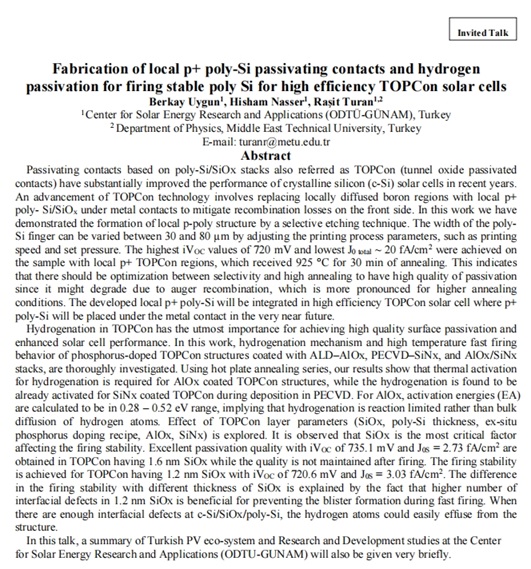| Fabrication of local p+ poly-Si passivating contacts and hydrogen passivation for firing stable poly Si for high efficiency TOPCon solar cells【Rasit Turan】 |
| 发布时间:2024-10-21 | 浏览次数:332 |
Fabrication of local p+ poly-Si passivating contacts and hydrogen passivation for firing stable poly Si for high efficiency TOPCon solar cells Berkay Uygun1, Hisham Nasser1, Rasit Turan1,2 1 Center for Solar Energy Research and Applications (ODTÜ-GÜNAM), Turkey 2 Department of Physics, Middle East Technical University, Turkey E-mail: turanr@metu.edu.tr Abstract Passivating contacts based on poly-Si/SiOx stacks also referred as TOPCon (tunnel oxide passivated contacts) have substantially improved the performance of crystalline silicon (c-Si) solar cells in recent years. An advancement of TOPCon technology involves replacing locally diffused boron regions with local p+ poly- Si/SiOx under metal contacts to mitigate recombination losses on the front side. In this work we have demonstrated the formation of local p-poly structure by a selective etching technique. The width of the poly-Si finger can be varied between 30 and 80 µm by adjusting the printing process parameters, such as printing speed and set pressure. The highest iVOC values of 720 mV and lowest J0 total ~ 20 fA/cm2 were achieved on the sample with local p+ TOPCon regions, which received 925 °C for 30 min of annealing. This indicates that there should be optimization between selectivity and high annealing to have high quality of passivation since it might degrade due to auger recombination, which is more pronounced for higher annealing conditions. The developed local p+ poly-Si will be integrated in high efficiency TOPCon solar cell where p+ poly-Si will be placed under the metal contact in the very near future. Hydrogenation in TOPCon has the utmost importance for achieving high quality surface passivation and enhanced solar cell performance. In this work, hydrogenation mechanism and high temperature fast firing behavior of phosphorus-doped TOPCon structures coated with ALD‒AlOx, PECVD‒SiNx, and AlOx/SiNx stacks, are thoroughly investigated. Using hot plate annealing series, our results show that thermal activation for hydrogenation is required for AlOx coated TOPCon structures, while the hydrogenation is found to be already activated for SiNx coated TOPCon during deposition in PECVD. For AlOx, activation energies (EA) are calculated to be in 0.28 ‒ 0.52 eV range, implying that hydrogenation is reaction limited rather than bulk diffusion of hydrogen atoms. Effect of TOPCon layer parameters (SiOx, poly-Si thickness, ex-situ phosphorus doping recipe, AlOx, SiNx) is explored. It is observed that SiOx is the most critical factor affecting the firing stability. Excellent passivation quality with iVOC of 735.1 mV and J0S = 2.73 fA/cm2 are obtained in TOPCon having 1.6 nm SiOx while the quality is not maintained after firing. The firing stability is achieved for TOPCon having 1.2 nm SiOx with iVOC of 720.6 mV and J0S = 3.03 fA/cm2. The difference in the firing stability with different thickness of SiOx is explained by the fact that higher number of interfacial defects in 1.2 nm SiOx is beneficial for preventing the blister formation during fast firing. When there are enough interfacial defects at c-Si/SiOx/poly-Si, the hydrogen atoms could easily effuse from the structure. In this talk, a summary of Turkish PV eco-system and Research and Development studies at the Center for Solar Energy Research and Applications (ODTU-GUNAM) will also be given very briefly.
|






